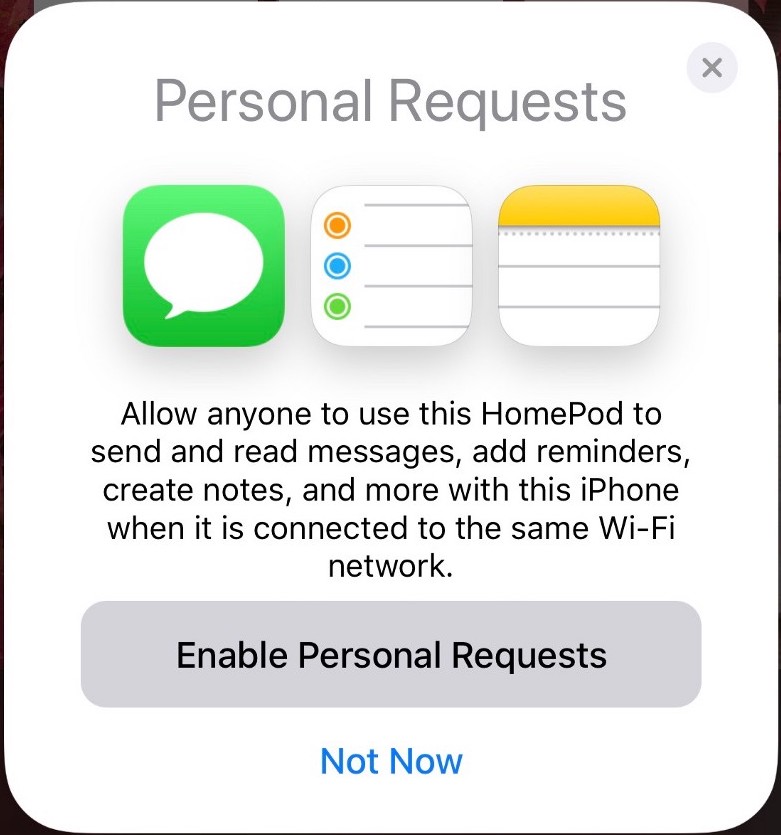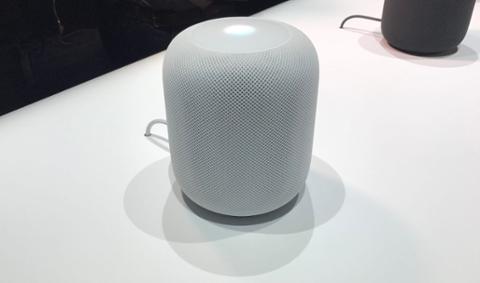- Start a call
- Set multiple timers
- Read recent messages (however, HomePod will read incoming messages)
- Access your Calendar
- Read back your emails
- Add multiple items to a list via a single ‘hey Siri’ command
 ‘Hey Siri’ is the most frequent interaction you’ll have with HomePod, and it doesn’t identify individual voices: You, a roommate, or family member can ask HomePod/Siri to do anything. The top of the device is touch-capacitive, but it’s mostly to activate Siri and control volume. HomePod is great for music playback, which is where Apple is hanging its proverbial hat. Sound is subjective to the listener, but I think HomePod is great. It has low bass notes and high trebles, but also does an admirable job of plucking unique rhythms or features from songs and making sure you hear them. Some songs just plain sound better with HomePod, even compared to great over-ear headphones. Self-proclaimed audiophiles love it. Some are bashing Apple’s choice to limit HomePod to Apple Music (which is likely more about Siri's capabilities than Apple seeking a competitive edge against Spotify and other streaming services). Just in time for HomePod’s release, Siri got some deep learning about Apple Music’s various artists and genres. It can still operate as a Bluetooth speaker if you have Spotify or another service. Versus various home speaker offerings from Google and Amazon, there’s little comparison. Even Sonos has trouble keeping up with HomePod in terms of audio quality. The device's small footprint is also helpful. Here’s a good comparison (I suggest using headphones to listen to the embedded video):
‘Hey Siri’ is the most frequent interaction you’ll have with HomePod, and it doesn’t identify individual voices: You, a roommate, or family member can ask HomePod/Siri to do anything. The top of the device is touch-capacitive, but it’s mostly to activate Siri and control volume. HomePod is great for music playback, which is where Apple is hanging its proverbial hat. Sound is subjective to the listener, but I think HomePod is great. It has low bass notes and high trebles, but also does an admirable job of plucking unique rhythms or features from songs and making sure you hear them. Some songs just plain sound better with HomePod, even compared to great over-ear headphones. Self-proclaimed audiophiles love it. Some are bashing Apple’s choice to limit HomePod to Apple Music (which is likely more about Siri's capabilities than Apple seeking a competitive edge against Spotify and other streaming services). Just in time for HomePod’s release, Siri got some deep learning about Apple Music’s various artists and genres. It can still operate as a Bluetooth speaker if you have Spotify or another service. Versus various home speaker offerings from Google and Amazon, there’s little comparison. Even Sonos has trouble keeping up with HomePod in terms of audio quality. The device's small footprint is also helpful. Here’s a good comparison (I suggest using headphones to listen to the embedded video):
How Apple's new HomePod stacks up against Google Home and Amazon Echo pic.twitter.com/FkhgiqQXPg
— The Verge (@verge) February 12, 2018
HomeKit Still Has No Home
Aside from excellent sound and a small footprint, HomePod is a HomeKit hub. This is where the investment is truly made. Unlike Google and Amazon, Apple’s connected home platform uses encrypted communication between devices on your WiFi network. That previously slowed third-party developers from jumping onto the HomeKit platform, but it's no longer a valid concern; there’s enough in the HomeKit ecosystem to completely connect an entire home with aplomb. You can ask Siri to turn lights on, unlock doors, and various other actions. What you can’t do is make a HomePod part of a "scene," or sequence of events activated by a single command (for example, saying, "Hey Siri, good morning," and having the house lights switch on and the doors unlock, provided that hardware is HomeKit-supported). HomePod is found in the ‘Home’ app on an iPhone or iPad, but it can’t be added to scenes; you also can’t control its volume via the Home app, or turn it off. Scenes are where HomePod shows its limits in the HomeKit context. If you wanted to have a ‘hey Siri, good morning’ command turn on lights, open blinds, trigger a coffee machine, and have HomePod start reading you the news, it’s all possible – save for the news. As with an iPhone or iPad, HomePod is treated as a control center, not an accessory. When you set a HomePod up, it asks which room it’s in. This is handy for HomeKit, because you can ask Siri via the HomePod to control items in the room you’re in. Rather than saying ‘hey Siri, turn on the living room lights’ while you’re in the living room, you can just say ‘hey Siri, turn on the lights.’ So long as both those lights and HomePod are noted in the Home app as being in the living room, Siri keeps track. I have two of my HomePods in an open floorplan where the kitchen blends into the living area. Apple has crafted proximity for HomePod, so it won’t turn living room lights on if I’m closer to the Kitchen HomePod. It’s the little things. [caption id="attachment_146508" align="aligncenter" width="2048"] HomePod has a mesh fabric cover.[/caption]
HomePod has a mesh fabric cover.[/caption]


